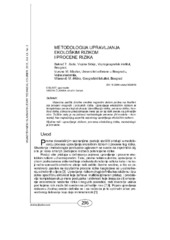Приказ основних података о документу
Methodology of environmental risk assessment management
Metodologija upravljanja ekološkim rizikom i procene rizika
| dc.creator | Bakrač, Saša T. | |
| dc.creator | Vuruna, Mladen M. | |
| dc.creator | Milanović, Miško | |
| dc.date.accessioned | 2021-09-24T15:25:09Z | |
| dc.date.available | 2021-09-24T15:25:09Z | |
| dc.date.issued | 2012 | |
| dc.identifier.issn | 0042-8469 | |
| dc.identifier.uri | https://gery.gef.bg.ac.rs/handle/123456789/508 | |
| dc.description.abstract | Successful protection of environment is mostly based on high-quality assessment of potential and present risks. Environmental risk management is a complex process which includes: identification, assessment and control of risk, namely taking measures in order to minimize the risk to an acceptable level. Environmental risk management methodology: In addition to these phases in the management of environmental risk, appropriate measures that affect the reduction of risk occurrence should be implemented: - normative and legal regulations (laws and regulations), - appropriate organizational structures in society, and - establishing quality monitoring of environment. The emphasis is placed on the application of assessment methodologies (three-model concept), as the most important aspect of successful management of environmental risk. Risk assessment methodology - European concept: The first concept of ecological risk assessment methodology is based on the so-called European model-concept. In order to better understand this ecological risk assessment methodology, two concepts - hazard and risk - are introduced. The European concept of environmental risk assessment has the following phases in its implementation: identification of hazard (danger), identification of consequences (if there is hazard), estimate of the scale of consequences, estimate of consequence probability and risk assessment (also called risk characterization). The European concept is often used to assess risk in the environment as a model for addressing the distribution of stressors along the source - path - receptor line. Risk assessment methodology - Canadian concept: The second concept of the methodology of environmental risk assessment is based on the so-called Canadian model-concept. The assessment of ecological risk includes risk arising from natural events (floods, extreme weather conditions, etc.), technological processes and products, agents (chemical, biological, radiological, etc.) and industrial activities that may pose threats to ecosystems, flora, fauna and humans. This model-concept gives a three-phase assessment where the assessor tries to determine whether a specific place may be subject to assessment, to characterize the level of risk and to confirm or refute the findings of the first phase, collecting information and corrective measures, or to establish basic requirements for environment protection. Risk assessment methodology - American concept: The third methodological approach to environmental risk assessment is developed by the U.S. Agency for Environmental Protection, 'U.S. EPA'. This model primarily involves the implementation of environmental risk assessment under the conditions of anthropogenic impact on environment, without aiming at solving problems of natural environmental risks, although this methodology can be applied in this environment segment as well. The methodology gives a clear distinction between a scientific (phase of estimation) and a non-scientific (planning) part of assessment. The phases of estimation given by this model are: problem formulation, risk analysis and risk characterization. Conclusion: Concepts and methodologies of all three models-concepts of assessment are mostly reduced to a common goal: how to reduce existing or avoid potential risks. However, it should be noted that the implementation of appropriate management and ecological risk assessment does not guarantee that risks will be avoided or that the implementation of these processes will be successful. | en |
| dc.description.abstract | Uspešna zaštita životne sredine najvećim delom počiva na kvalitetnoj proceni mogućih i prisutnih rizika. Upravljanje ekološkim rizikom je kompleksan proces koji obuhvata: identifikaciju rizika, procenu rizika i kontrolu rizika, odnosno preduzimanje mera da se taj rizik svede na prihvatljiv nivo. Težište rada je na primeni metodologije procene (tri modela - koncepta), kao najvažnijeg aspekta uspešnog upravljanja ekološkim rizikom. | sr |
| dc.publisher | Beograd : Univerzitet odbrane u Beogradu - Institut za naučne informacije | |
| dc.rights | openAccess | |
| dc.rights.uri | https://creativecommons.org/licenses/by/4.0/ | |
| dc.source | Vojnotehnički glasnik | |
| dc.subject | risk management | en |
| dc.subject | environmental risk assessment | en |
| dc.subject | assessment methodology | en |
| dc.subject | upravljanje rizikom | sr |
| dc.subject | procena ekološkog rizika | sr |
| dc.subject | metodologija procene | sr |
| dc.title | Methodology of environmental risk assessment management | en |
| dc.title | Metodologija upravljanja ekološkim rizikom i procene rizika | sr |
| dc.type | article | |
| dc.rights.license | BY | |
| dcterms.abstract | Бакрач, Саша Т.; Вуруна, Младен М.; Милановић, Мишко; Методологија управљања еколошким ризиком и процене ризика; Методологија управљања еколошким ризиком и процене ризика; | |
| dc.citation.volume | 60 | |
| dc.citation.issue | 2 | |
| dc.citation.spage | 296 | |
| dc.citation.epage | 305 | |
| dc.citation.other | 60(2): 296-305 | |
| dc.citation.rank | M52 | |
| dc.identifier.doi | 10.5937/vojtehg1202296B | |
| dc.identifier.fulltext | https://gery.gef.bg.ac.rs/bitstream/id/431/506.pdf | |
| dc.identifier.rcub | https://hdl.handle.net/21.15107/rcub_gery_508 | |
| dc.type.version | publishedVersion |


